Producer, engineer and Superfreq co-founder Noël Jackson shows us around his LA studio, giving us an insight into the build process along the way.
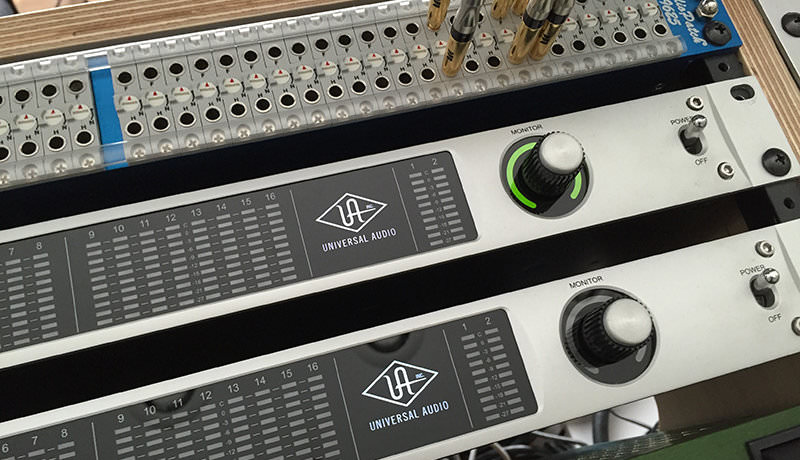
UA Audio Apollo 16 + Satelite
The Universal Audio converters are amazing. They are very clean, the clock is extremely precise and they are Thunderbolt-powered. For converters, I’d pick these as my second, next to the Burl Mothership, which costs six times as much, and isn’t justifiable for non-tracking work. My studio is equipped with two Apollo 16 converters plus another Apollo Satellite Octo box which gives me 16 DSP chips and 32 channels of audio in and out. This allows me to sum 32 channels of audio and mix in what we’re calling a ‘hybrid’ approach. Taking the best of in-the-box tech and physical, analogue realm headroom and combining them.
The DSP chips are where the magic lays. UAD has created some of the most precisely modelled plugins out there, that all run off of external processors, which means you aren’t clogging your CPU up every time you add a plugin to a channel. The API Vision Channel Strip, Neve 1073 and SSL G Comp are some of my go-to plugins. Especially for bass, like on ‘Behold A Pale Horse’ off my Behold EP, you can hear the API Vision Channel Strip working hard to keep those kicks and bass toms low and tight as can be.
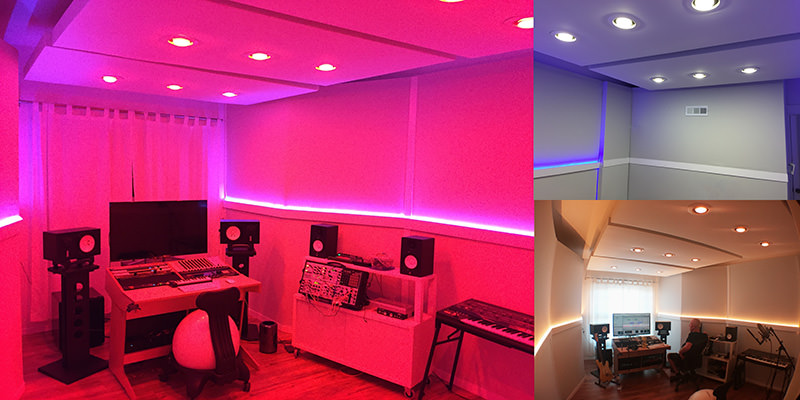


My Studio – Noël Jackson
My favourite piece of gear is my studio itself. Your sacred music space – your ‘room’ – is everything. The creation of my studio was a very detailed project that I collaborated on with Herman Virgen, an amazing acoustic engineer in Los Angeles who’s worked with people like Trey Songz, MixedByAli and Sham Joseph. We worked hard to manage compromises, and created a studio that specs out better than a large majority of ‘professional’ mixing rooms.
Taking acoustics and aesthetics into consideration, a 12 x 18 x 11 room was transformed into a beautiful space for creating music. Through detailed calculations, dozens of trips to Home Depot, some out of the box thinking, a concussion, and a few bandaids, my music and my mind was transformed. Creating something with your own bare hands is liberating. My arms are sore and my mind is still a little numb from reading Philip Newell books.
Side note: I’ve been asked many times about panels after people look at photos of my room. My studio doesn’t utilise panels – rather, the entire room is treated in a way that finds a perfect balance of aesthetics and sonics. There is a different approach to everything – exploring the options really opened my eyes.
Related
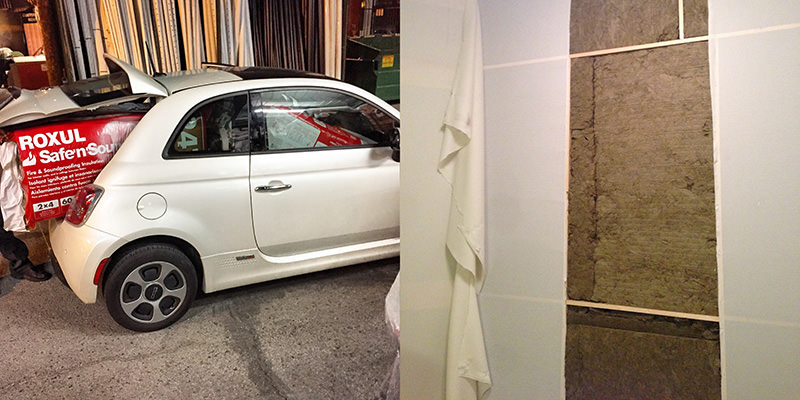


Roxul Safe’n’Sound
Acoustic treatment is the most important part of my studio. It leads to more precise and relaxed hearing, which leads to better production and mixing, while at the same time making your workflow more efficient. Untreated rooms are an excuse for ignoring acoustics, which is akin to ignoring physics (which is sound, which is music). Acoustics is everything and it will change your life – disagree at your peril!
Though I use a lot of different types and densities of insulation in my room, the most used is 24-inch Roxul Safe’n’Sound. It has a perfect density for large bass trapping as well as for treating most high frequency reflections. In building my studio I utilised 15 bundles of Roxul as well as a bundle of their 1-inch 8pcf material.
Related
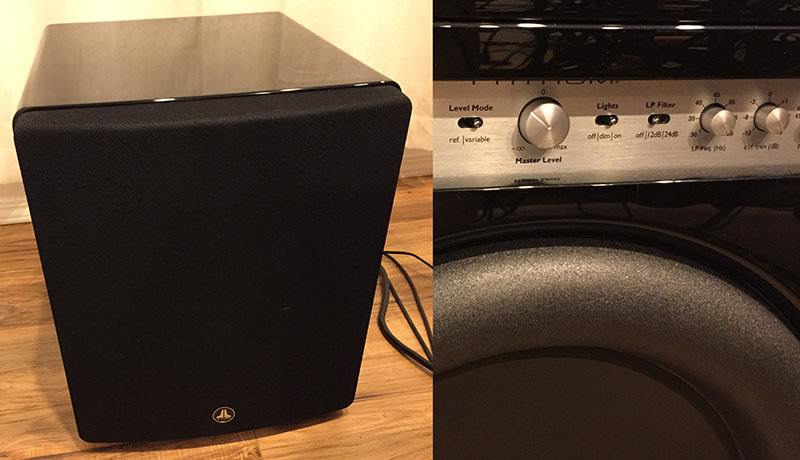


JL Fathom Sub
A lot of people ask how I get my bass and kicks sounding so good (they aren’t too shabby). The first trick is to be able to hear your kicks and bass really well. There are very few pieces of equipment that don’t have (much) room for improvement. The JL Fathom Sub is one of them.
Though using a sub can be tricky, if you take the time to learn how they work and find the correct placement in your room, you gain access to a realm of control that you otherwise would not have with a off the shelf three-way speaker. If your room has some acoustic modes you can’t seem to understand, moving your sub (lows) and your near fields (mids/highs) independently can help you easily get rid of some seemingly big problems.
The JL Fathom Sub has an insane transient response that makes all of your bass very articulate. It is a massive beast and requires two people to lift. Even though this is considered a ‘hi-fi’ sub, it isn’t, and its controls are absolutely unseen in most ‘studio’ subs. The crossover, phase, volume and calibration controls are incredible. If they had notched knobs it would be a nice touch, but the included calibration mic ends up making that an obsolete notion.
I originally borrowed this sub from Vintage King, loathingly, while my third set of three-way nearfields were being repaired. Coupled with NS-10s, I’ve never had the ability to produce on such a precise and articulate system. If you are sick of your bass being a guessing game, get amazing near fields and this sub.
Related



UA Audio Apollo 16 + Satelite
The Universal Audio converters are amazing. They are very clean, the clock is extremely precise and they are Thunderbolt-powered. For converters, I’d pick these as my second, next to the Burl Mothership, which costs six times as much, and isn’t justifiable for non-tracking work. My studio is equipped with two Apollo 16 converters plus another Apollo Satellite Octo box which gives me 16 DSP chips and 32 channels of audio in and out. This allows me to sum 32 channels of audio and mix in what we’re calling a ‘hybrid’ approach. Taking the best of in-the-box tech and physical, analogue realm headroom and combining them.
The DSP chips are where the magic lays. UAD has created some of the most precisely modelled plugins out there, that all run off of external processors, which means you aren’t clogging your CPU up every time you add a plugin to a channel. The API Vision Channel Strip, Neve 1073 and SSL G Comp are some of my go-to plugins. Especially for bass, like on ‘Behold A Pale Horse’ off my Behold EP, you can hear the API Vision Channel Strip working hard to keep those kicks and bass toms low and tight as can be.



My Studio – Noël Jackson
My favourite piece of gear is my studio itself. Your sacred music space – your ‘room’ – is everything. The creation of my studio was a very detailed project that I collaborated on with Herman Virgen, an amazing acoustic engineer in Los Angeles who’s worked with people like Trey Songz, MixedByAli and Sham Joseph. We worked hard to manage compromises, and created a studio that specs out better than a large majority of ‘professional’ mixing rooms.
Taking acoustics and aesthetics into consideration, a 12 x 18 x 11 room was transformed into a beautiful space for creating music. Through detailed calculations, dozens of trips to Home Depot, some out of the box thinking, a concussion, and a few bandaids, my music and my mind was transformed. Creating something with your own bare hands is liberating. My arms are sore and my mind is still a little numb from reading Philip Newell books.
Side note: I’ve been asked many times about panels after people look at photos of my room. My studio doesn’t utilise panels – rather, the entire room is treated in a way that finds a perfect balance of aesthetics and sonics. There is a different approach to everything – exploring the options really opened my eyes.
Related
Related
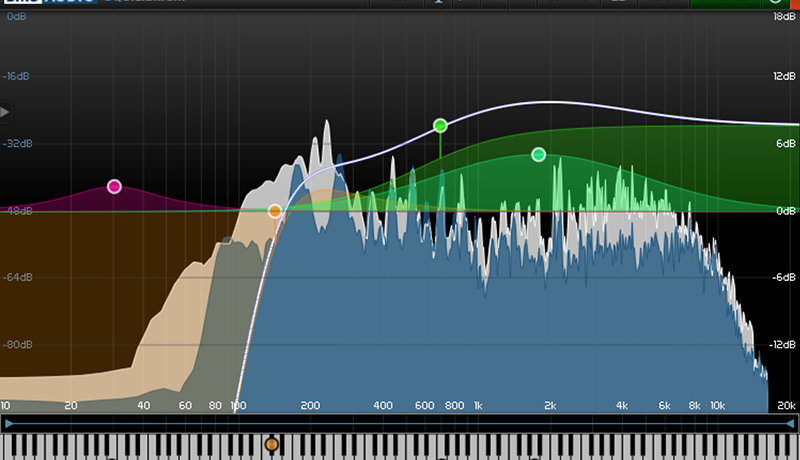


DMG Audio EQuilibrium
It’s not a piece of hardware, but the EQuilibrium EQ by DMG Audio is used on every project I touch. The transparent sound and control of this EQ is impressive and extremely useful. It can be configured as a master buss EQ, a mix EQ, and allows easy access to mid/side EQ and volume. This is an essential. Listen to the stereo separation on my latest EP and you’ll find this is part of the magic.
Related
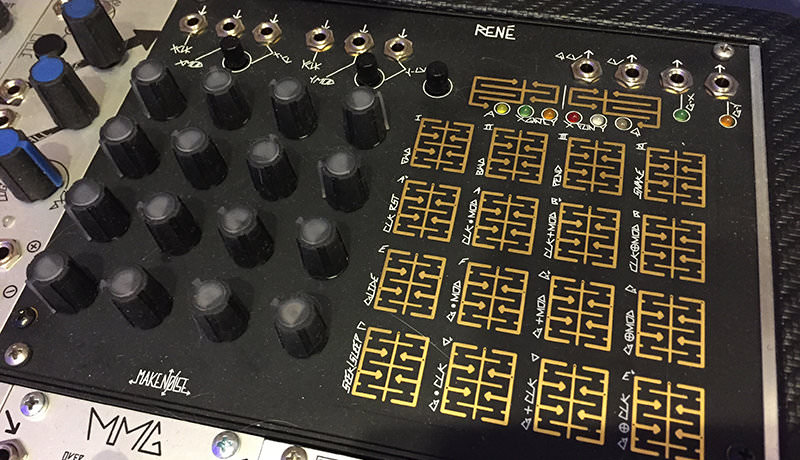


Make Noise René
When it comes to modular synth gear, Make Noise has been throwing some major game over the past few years. Though it looks like a simple sequencer, the René is highly unconventional. The sequencing pattern options, quantisation of CV signals, touch button interface and octave controlling knobs make this one mean beast. Throw it at some pads, some badass toms, or a rumbling bassline. You can hear my use of it on all the basslines I wrote on my latest EP, as well as on my release on Satsang. I also use it to sequence 303 acid lines like on my track ‘Alternate Dimension.’
Related
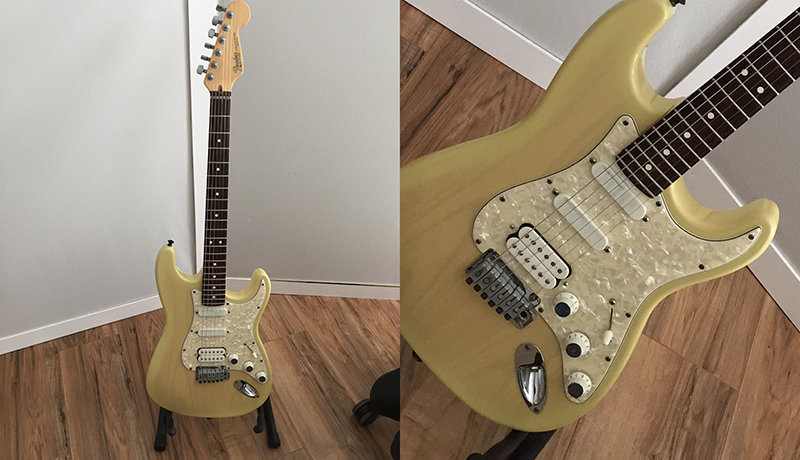


Fender Stratocaster Plus Deluxe
When I was 10 my parents let me put an American Fender Stratocaster Plus Deluxe in Creme colour with Lace Sensor pickups and a Floyd Rose bridge in layaway. I’d go to the store every Saturday and put some more money down on the guitar and jam out to it, shredding on a Crate amp. It took me four years of washing dishes, but one fateful day in 1997 I had enough cash to take the baby home. I still use it on a regular basis even for techno and house tunes – combined with some plugins and a few synth modules it creates some incredible sounds. It’s the piece in my studio that reminds me on a daily basis what dedication means. Almost all of my EPs contain a little bit of it, especially my Acid Test EP that has lots of feedback during the breaks.
Related
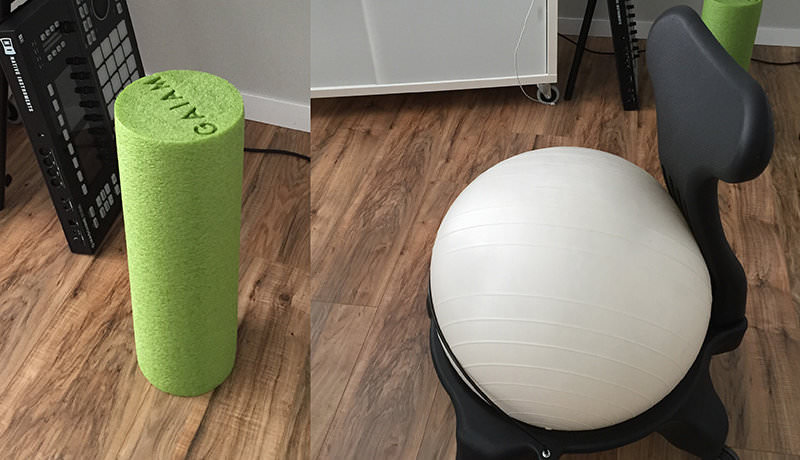


Foam Roller & Exercise Ball
You have to stay in healthy mental and physical shape. Musicians have turned into computer geeks and computer geeks have turned into musicians, which means that everyone has back pain and incredibly bad posture. The foam roller helps you keep your back straight, your muscles loose and gives you a good excuse to take a quick break during long sessions. The exercise ball chair is goofy looking but pretty amazing for long sessions and playing awkward games of basketball.
Related
Noël Jackson’s Behold EP is out now on Superfreq. Find him on Facebook
, Twitter and SoundCloud
.
Related
20th October, 2015
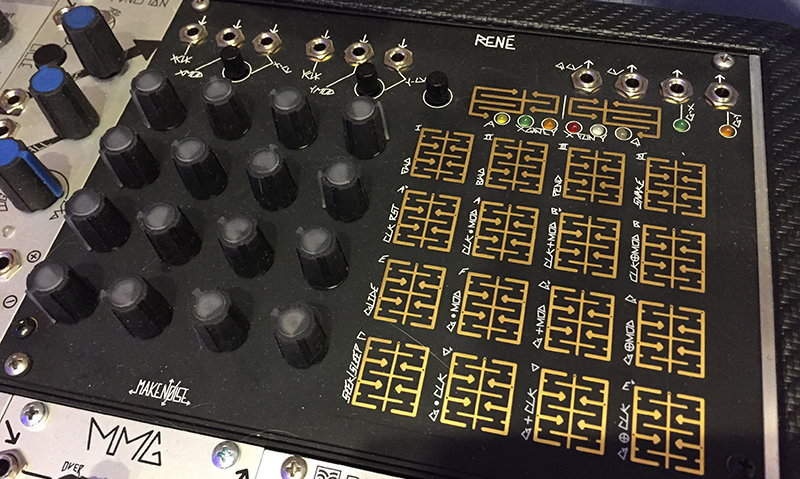
11.09 AM
funny how many of these “my studio” articles imo tend to focus on mundane items, cute thingies, generic, widely used or unrelated (to electronic music) gear, etc..
gee artist xyz got in his studio a sh101, a TR909, a dx7 and ableton on a screen, with a lava lamp, a hand decorated bongo drum next to a laotian incense burner…
sorry, this is not meant to be mean, but frequently these studio descriptions seem to be there almost for “entertainment” rather than for real information.
they rarely elucidate the “sound” of the artist, what makes it personal, how the gear functions separately and together. maybe it’s considered trade secrets. if so then “my studio” series is more akin to a decorator or a lifestyle chronicle.
or maybe i am being unfair and expecting too much…
08.45 PM
I get what you mean @dk_zone, but I also kind of like that the articles reflect things that the artists think are important for their mood/workflow. It is kind of frustrating when you are wanting to learn about gear and how to incorporate it into a studio, but at least that information is available elsewhere in most cases.
07.07 AM
No you are being perfectly fair @dk_zone …. Some of these studio tours are really lame. This one and the other one in a dark room are really worthless.
09.45 PM
Fair enough. The format of these articles is pretty heavily set in stone. I’d love to actually answer questions or talk about things you want to hear about. Some more detailed articles on my studio build and more will be on my personal web site in the bar future: http://noeljackson.com
Why was this worthless though? Seems like a fair bit more info I put out regarding specifics than most. What would you like to hear? I’ll answer any question you can throw at me. Go for it. Anything. Compression, EQ, summing, patch bays, wiring, acoustics…
Thanks for being honest.
X
-Noël
09.58 PM
Just to be straight up. I wouldn’t be caught dead with incense or a lava lamp in my studio.
Tell Attack Magazine what you want. People like me are willing to talk about whatever they’re asked, if they are given the space to talk about it. Unlike many producers and engineers.
01.45 AM
I think that the point of these features is mostly inspiration with a healthy dose of gearporn time-wasting thrown in. These studio tours are almost never truly in-depth enough to glean any useful tips or secrets. Even the longer studio tour-style features on sites like Future Music are really just glamour shots an demos of already legendary bits of gear. Not a lot to be learned about how the gear works or how to improve one’s music. They are, however, inspiring and energizing. If you want real insight or knowledge, there are lots of great tutorials and lengthy features out there on this and other websites. I enjoy these features and like seeing how much people can get out of their home studios.
09.27 AM
@hanzhebie I am writing up the entire build process for my studio. It currently is around 10 pages, which I’m editing down. 🙂 Hope at least the info I provided here is of some inspiration and the full article will be really helpful.
To be fair – I’m answering questions, but all anyone has done is complained – not asked a question in public – it’s been all private emails that I’ve responded to.
10.51 AM
Noël, I appreciated the studio tour and I think your offer to answer questions is very generous.
What would you recommend to someone who wants to get a good balanced sound but can’t dedicate a room to acoustic treatment and ideal speaker placement?
My room isn’t awful, but it’s small and because it’s shared living space I can’t bring the speakers too far away from the walls or put bass traps in the corners. Are headphone mixes the best I can do for mixing bass?
03.26 PM
I don’t think the critics or unjustified here – but – I do think people are being ungrateful and rude with their criticism. I think there is always something to glean from these studio tours – be it in the pictures or the descriptions given. If you are looking for A+B=Chart Hit then keep looking. There is so much information hidden in this tour. We know there is a huge element in the “vibe” of his studio which tells us a lot about his creative process. He uses processes the encourage randomness or chaos (Rene). We know he likes hardware but does not discriminate when it comes to high quality plugins. Plus getting to know the person through his writing is always interesting.
I’m not trying to hate on haters – just saying let’s be more appreciative of the time spent by these artists. I know I would be pretty disappointed to write up a passionate studio tour like this one and find a bunch of people complaining about it.
Noel – cheers to you! I love your studio tour – space looks beautiful and must encourage the creative process. I feel as I have learned much about you as a person and an artist. Thank you for your time!
05.01 AM
@Nerd: The answer to your question is to find compromise and use headphones 🙂 My best suggestion is to try to find the best spot for your speakers first. A lot of the time, it’s actually not 3/8ths of the way back in the room, it could be with your speakers pushed all the way up against the wall to be honest. Try what you can with positioning, then try to at the very least get rid of reflections by using high frequency absorbers. Just one layer of 8pcf Roxul or Owens Corning 705 with nice fabric over it will help a ton. The most important thing to individuals when discerning if they enjoy a room’s acoustics is typically reverberation time. Unfortunately small rooms are hard to treat for that without going all the way, and it’s easier to mix on a simple speaker without a sub, like the Equator D5 or Yamaha NS10s – even the new Yamaha 5″ powered speaker is really quite nice. You won’t solve your room problems with a “better” speaker in my opinion. A good set of headphones will probably be your best friend at the end of the day. I wouldn’t go anywhere without my Audio Technica ATH-M50 cans. Hope that helps and wasn’t just redundant.
05.02 AM
@Osro Thanks for being a genuine human being. Appreciate the kind and eloquent words. 🙂
02.29 PM
Noël. Thanks. No, not redundant at all. Very good, succinct advice.
Just one follow up though, and this may be hard to answer, but what should I be listening for when moving around and trying to find the sweet spot in my room? It’s hard to know when I’ve found the spot having never heard a proper room before, sadly.
06.49 AM
@Noël Jackson … Ok sorry about saying this was worthless. The fact that you responded to the readers and answered some questions makes this a good My Studio feature. Manny times we are left with a few dark grainy pictures and not much of a guess at the artists chain/process. The fact that you offer up some advice raise’s the value of this particular tour. My apologies.
One question for you. What keyboard is in the first picture on the right and is there anything special about it?
09.08 PM
@Nerd Listen for the “flame” of the speakers – that’s vague but you know it when everything comes into its own and you feel like you aren’t too far near or away from the speakers. It’s probably an equilateral triangle try moving that equilateral triangle towards and then away from the wall. Try some of the calculators out there for finding the best listening position as well.
09.12 PM
@David Apologies not needed! I just want the time I put into anything – even the press coverage – to be useful. Appreciate you coming back to comment.
The keyboard to the right is very special actually! It’s a Jupiter 6 that Mr.C gave to me. It was used by The Shamen for a long time while they were on tour. When it first arrived it was severely broken. Now it’s repaired and being put to good use.
11.58 PM
@Noël Thanks for the info on the keyboard. I had to know what the keyboard is as its the only one I could see but couldn’t make out what it was. I guess if your going to own only one keyboard that’s a really good choice.. or the Jupitor 8.
04.29 AM
@David Yes! It’s a great synth… But I do have more… The synths didn’t make it into the photos. I’ll post my synth rack once it doesn’t look like a mess.. 🙂
06.53 PM
What! You have synths and you didn’t show us! 🙂
02.09 AM
@David 🙂 Follow me on Instagram and you’ll see them once I get my Jasper Alu stand all organized. http://instagram.com/noeljacksonoficial
02.09 AM
Oops… http://instagram.com/noeljacksonofficial